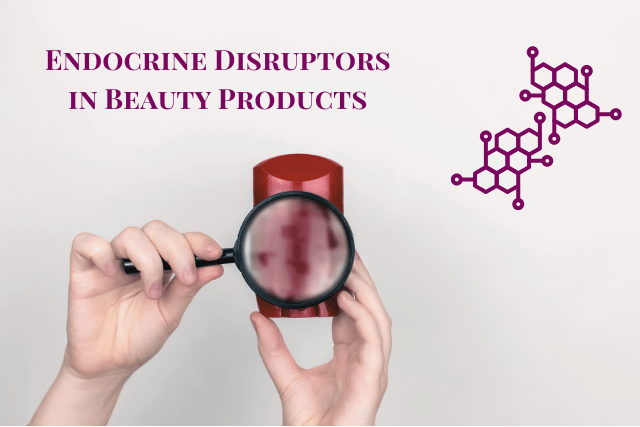Most people focus on diet and topical skincare when trying to clear their skin, but what if the problem runs deeper? Hidden endocrine disruptors in your beauty products could be affecting your hormones, skin, and overall well-being.
I’ve seen this firsthand in my clinic. One of my clients, a woman in her early 30s, struggled with persistent breakouts, irregular cycles, and fatigue. She was doing all the “right” things—eating clean, exercising, and using expensive skincare. But when we took a deeper look, her beauty routine was full of hormone-disrupting chemicals, including synthetic fragrances, parabens, and oxybenzone in her sunscreen. Within weeks of switching to clean alternatives, she saw a huge improvement in her skin and energy levels.
From synthetic fragrances to preservatives, parabens to phthalates, these hormone-disrupting chemicals mimic or block natural hormones like oestrogen, progesterone, and testosterone, leading to breakouts, PMS, fatigue, and metabolic imbalances.
So how do you know if your beauty routine is working for or against your hormones? In this guide, I’ll break down: ✅ What endocrine disruptors are & how they impact your skin and hormones
✅ The top hidden hormone disruptors in beauty products
✅ Small swaps to start detoxing your routine today
What Are Endocrine Disruptors & Why Do They Matter for Skin & Hormones?
Endocrine disruptors are chemicals that interfere with your hormonal signalling system, leading to imbalances that can show up in your skin, mood, metabolism, and menstrual cycle.
How They Work:
- Mimic natural hormones (e.g., xenoestrogens that act like oestrogen, worsening hormonal acne)
- Block hormone receptors, preventing proper hormonal function (e.g., thyroid-disrupting chemicals that lead to dry skin and fatigue)
- Disrupt hormone metabolism, making it harder for your liver to clear excess hormones (leading to bloating, weight gain, and inflammation)
The Top Hormone-Disrupting Chemicals in Beauty Products
Parabens – Found in lotions, moisturisers, shampoos, and deodorants. These mimic oestrogen and are linked to hormone-related cancers.
Phthalates – Often hidden under “fragrance” in perfumes, skincare, and hair products. These endocrine blockers interfere with oestrogen and testosterone balance.
Triclosan – Found in antibacterial soaps, toothpaste, and some deodorants. It disrupts thyroid hormones and can contribute to skin irritation.
Synthetic Fragrances – A mix of unknown chemicals that can include phthalates and other endocrine system disruptors.
Oxybenzone & Chemical Sunscreens – A known oestrogen disruptor found in most conventional sunscreens.
I personally experienced the effects of synthetic fragrance overload during pregnancy. Walking through department stores, I had to completely avoid the perfume section—it was overwhelming, making it impossible to breathe and leaving me feeling nauseous. The scent would hit me so hard that I’d feel dizzy and sick for hours afterward. At the time, I didn’t understand why my body was reacting so strongly, but looking back, it was a clear warning sign.
Years later, as I learned more about synthetic fragrances, hormonal shifts, and skin reactions, everything clicked. These chemicals weren’t just irritating my senses—they were interfering with my hormones in ways I hadn’t realised. That experience pushed me to reevaluate the products I was using daily, and I haven’t looked back since.
Simple Swaps to Detox Your Beauty Routine
✅ Switch to Clean Beauty Products
- Look for brands labelled paraben-free, phthalate-free, and fragrance-free
- Choose mineral-based sunscreens instead of chemical filters
- Avoid titanium dioxide, which is commonly used in mineral makeup and sunscreens but has raised concerns regarding inhalation safety and nanoparticle exposure.
- I personally use and recommend MG Naturals, because they are titanium dioxide-free. For a deeply hydrating, clean formula free from endocrine disruptors, I also use my own Biostem Skin Cream.
- Look for brands labelled paraben-free, phthalate-free, and fragrance-free
- Choose mineral-based sunscreens instead of chemical filters
✅ Ditch Synthetic Fragrances
- Opt for fragrance-free skincare and household products
- Use natural deodorants instead of aluminium-based antiperspirants
✅ Read Labels & Choose Safer Alternatives
- Check for hormone-safe certification or EWG-verified products
- Choose organic, non-toxic skincare brands
Want the Full Detox Plan?
This is just one part of the bigger picture. Endocrine disruptors are also hiding in non-stick cookware, household cleaners, water, and food storage—all of which can impact your hormones.
That’s why I created the Hormone-Disrupting Chemicals Detox Cheat Sheet: a step-by-step guide to removing these toxins from your home, skincare, and kitchen.
Grab your copy here: Hormone-Disrupting Chemicals Detox Cheat Sheet – Elita Dabrowski
OR
Need a personalised hormone detox plan? Book a consultation and I’ll create a tailored strategy for you.
Final Thoughts
Your beauty products should support your skin and hormones—not disrupt them. Making simple swaps can help you feel more balanced, energised, and clear-skinned.
Start small—one change at a time makes a big impact!
Have you switched to hormone-safe beauty products? Let me know in the comments!


0 Comments